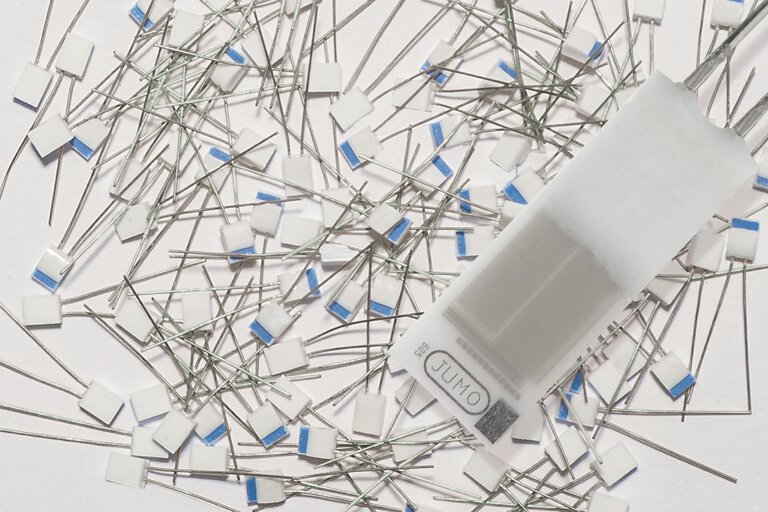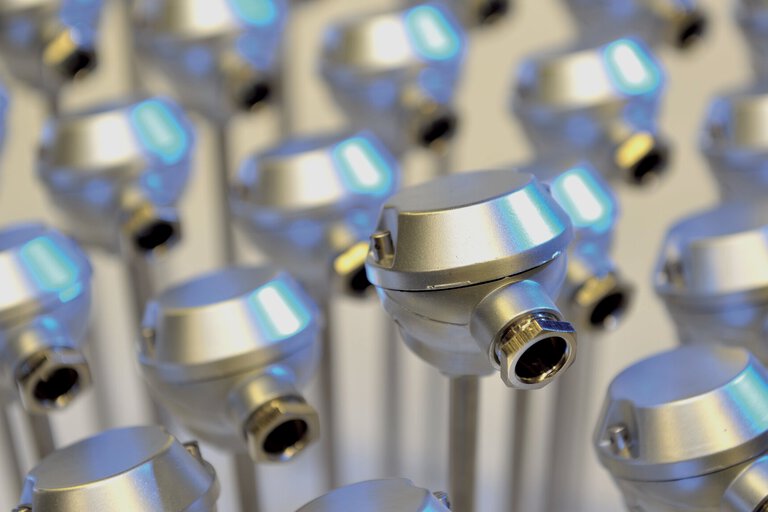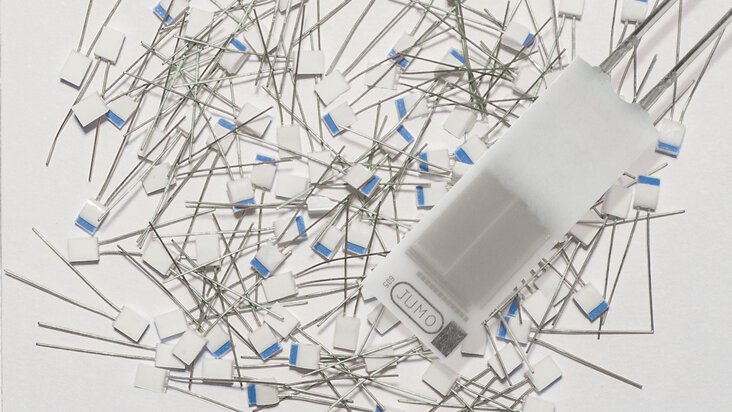
What are temperature sensors?
Temperature sensors are electronic components that provide an electrical signal as a measure of temperature. Platinum has established itself as the resistance material for temperature sensors in industrial measurement technology. Its advantages include high chemical resistance, comparatively easy workability (especially for wire production), the possibility of high-purity representation and good reproducibility of the electrical properties. These properties are fully specified in the European standard DIN EN 60 751, so that there is universal interchangeability for the platinum measuring resistance like hardly any other temperature sensor. These specifications include the temperature dependence of the resistor, which is defined in a basic value series, the nominal value, the associated reference temperature and the permissible limit deviations. The temperature range is also specified in the standard, ranging from -200 to +850°C.
Table of content
What are temperature sensors?
Temperature sensors are electronic components that provide an electrical signal as a measure of temperature. Platinum has established itself as the resistance material for temperature sensors in industrial measurement technology. Its advantages include high chemical resistance, comparatively easy workability (especially for wire production), the possibility of high-purity representation and good reproducibility of the electrical properties.
These properties are fully specified in the European standard DIN EN 60 751, so that there is universal interchangeability for the platinum measuring resistance like hardly any other temperature sensor.These specifications include the temperature dependence of the resistor, which is defined in a basic value series, the nominal value, the associated reference temperature and the permissible limit deviations. The temperature range is also specified in the standard, ranging from -200 to +850°C.
What types (designs) of temperature sensors exist?
The design of the platinum sensor differs according to the area of application; in principle, in the past a distinction was made between wirewound and thin-film resistors. While thin-film resistors always consist of a platinum layer applied to a ceramic substrate, wire-wound resistors can have the wire coil melted into glass or embedded in powder. In the meantime, thin-film resistors have established themselves in industry. Platinum chip temperature sensors with connecting wires or in SMD design are preferred.
How is a temperature sensor constructed? What are the differences?
There are various designs of platinum chip temperature sensors with connecting wires within the series, which essentially differ in the following characteristics:
- material of the connecting wire (silver, platinum, palladium, nickel, gold-plated nickel or tin-plated nickel)
- in the processing method (soft soldering, brazing, crimping or welding)
- in the operating temperature (from -70°C to max. + 600°C)
The platinum chip temperature sensor in SMD design does not have so many different versions compared to sensors with connecting wires. The main distinguishing feature here is the placement of the contact area. This can be manufactured as an all-round contact, as a one-sided contact or with a one-sided contact and solderable rear side. Compared to designs with lead wires, SMD temperature sensors are specially designed for automatic assembly on printed circuit boards in large series production.
What is the nominal value of a temperature sensor?
A temperature sensor is available in different nominal values. These are usually Pt100, Pt500 or Pt1000.

The nominal value or nominal resistance R0 is the resistance value at 0°C. According to DIN EN 60 751, a value of 100 Ω is defined for the nominal value, therefore it is called Pt 100 resistance. Multiples of this value are also permissible, so measuring resistors with nominal values of 500 Ω and 1000 Ω are offered. Their advantage is a higher sensitivity, i.e. a greater change in resistance with temperature (Pt 100: approx. 0.4Ω/K; Pt 500: approx. 2.0 Ω /K; Pt 1000: 4.0 Ω /K).

Pt100 curve
How are temperature sensors used in the resistance thermometer?
In the video you will get an overview of the design and operation of resistance thermometers in which temperature sensors are used.
How accurate are temperature sensors?
The accuracy of temperature sensors is divided into so-called tolerance classes or accuracy classes. There are 4 accuracy classes: F0.1; F0.15; F0.3 and F0.6. For each class a maximum tolerance or limit deviation is defined.
Accuracy classes for measuring resistors:
|
For layer resistors |
Limit deviationa °C |
|
|
Class |
Scope °C |
|
|
F 0,1 |
0 bis +150 |
± (0,1 + 0,0017|t|) |
|
F 0,15 |
-30 bis +300 |
± (0,15 + 0,002|t|) |
|
F 0,3 |
-50 bis +500 |
± (0,3 + 0,005|t|) |
|
F 0,6 |
-50 bis +600 |
± (0,6 + 0,01|t|) |
|
a|t|= absolute value of the temperature in °C without consideration of the sign |
||
Where are temperature sensors used in industry?
Platinum chip temperature sensors with a nominal value of Pt100, but also Pt1000 and Pt500 are not usually used for temperature measurement in this way. They are installed accordingly and thus result in a temperature sensor suitable for industrial use, a so-called RTD temperature probes.
- ${title}${badge}



